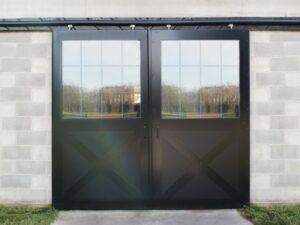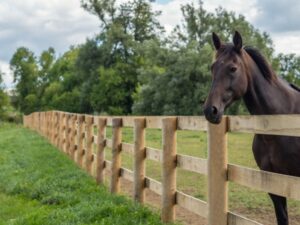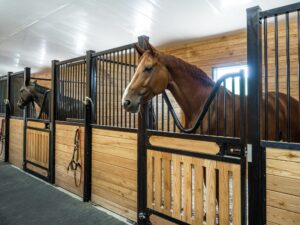Do your horses live outside on your outdoor horse farm or in outdoor boarding? Are they turned out for only 1-2 hours at a time?
Maybe you’re considering building a new paddock from scratch or remodeling your current paddock?
In both these cases, you will need to ensure that your farm is equipped with the right solutions and facilities to keep your horses happy and safe.
As a result, you’ll have to consider fencing along your property or paddock area. But here’s the thing, there are so many options available that you may be overwhelmed by choice, which makes it difficult to choose, not only for you but also for your horses, and your budget.
Typically, you’ll have the choice of some of the following types of fencing:
- Electric fencing
- Shockline
- Electric Tape either 1.5” to 4” wide
- Rope
- Braid
- Flex fencing
- Raceline
- Coated Wire
- Traditional Wood fencing
- Softwood
- Hardwood
- Wire fencing
- Paige Wire – Farm Fence
- 2×4 mesh –
- Diamond mesh
- High Tensile
- PVC fencing
It’s essential to learn the differences between these types of fences and the advantages and disadvantages of each, for you to make an informed buying decision. Typically, you’ll have to consider things like cost, maintenance, and effectiveness to weigh up the different options.
And keep in mind, what may be ideal for one person’s farm or horses may not necessarily work best for you. To make this process a bit easier, we’ll look at electric fencing in more detail in this article.
What is Electric Horse Fencing?
In simple terms, an electric horse fence is an electric barrier that you use to keep your horses safe and contained. It’s the best option to gain horses’ respect for boundary fences, and it’s also relatively inexpensive compared to other fencing options.
In respect of electric fencing, you basically have two options. The first is electric strand fencing, and the other is electric tape fencing. Typically, electric tape fencing is the safest and easiest to install and requires very little maintenance.
Despite this, they both work in the same way.
How Does Electric Horse Fencing Work?
Electric fencing has the following components:
- Fence energizer, Fence Charger, that emits a high voltage current pulse through the wire.
- Conductor, which is typically a wire of some sort. This can include anything from tape with either tinned copper or stainless conductor, plastic with either a high tensile wire or stainless wire or straight high tensile wire, or other types of material for conducting the electricity through the fence.
- Posts where the conductor is fitted to. These posts will typically be in the form of wooden posts for a permanent installation or T-posts if the installation is temporary. Another option are plastic posts with insulators built right into the posts, good for temporary applications.
- Insulators that insulate the conducting wires from the wooden or steel posts prevent the electricity from flowing to the ground. Insulators can either be within 1-2: of the posts or made with an offset to keep conductor wire or tape approximately 8-12” away for the posts or rail – many type of insulators (link to insulators)
Earthing, ground rods, ground field, which allows the circuit to be completed and the power back to the energizer if the conductor is touched by either an animal or a human. This creates a loop in the circuit and delivers the shock, should a horse touch the fence.
The fence energizer, also sometimes called the fence charger, converts electricity into intense electrical pulses that travel down the fence wires about every second. This means the electricity travels and pulses through the whole perimeter constantly. When one of your horses touches the fence, it completes the circuit.
As a result, the electrical pulse moves through its body, into the ground, and back to the fence energizer. The horse then feels an electrical shock.
It’s essential to keep in mind that older electric fences weren’t as effective as new fences that use modern fence energizers. These old fences had lower power outputs, and they wouldn’t electrify much of the fence. Also, any contact with grass or branches could easily short out the system, which would make the entire fence ineffective.
Today’s fence energizers generally have a higher voltage output but with a lower amperage rating. This results in the voltage traveling further along the fence, and it’s not as prone to electrical shorts because of grass or branches.
As such, modern fences are much more effective than the older ones. Many of the newer fencers are Low Impedance fencers and have lesser resistance and will go a further distance.
One of the most important things, though, is that the fence is correctly installed. In simple terms, the fence is only as effective as its installation. If not done correctly, it will reduce the efficacy of the fence.
Typically, electric fencing is only as good as the grounding, or grounding field that you have. If the voltage can not make it back to the grounding rods, then it will not complete the circuit and will not give a shock.
Now the question is whether this is dangerous. Apart from feeling the short shock from the electric fence, the after-effects are short-lived, and it doesn’t physically harm your horses.
As such, it doesn’t pose a physical threat to your horses, but it’s certainly memorable and forms a psychological barrier where your horses then associate the electrical shock with the fence and, in the future, avoids crossing it.
Now, the next question is whether it stresses your horses. And here, the answer is also no. Typically, it results in horses standing further away from the fence, but it doesn’t lead to increased stress.
Benefits of Using Electric Fences
Now that you know what electric horse fencing is and how it works, let’s look at some of the benefits should you use electric fencing.
These include:
Containment
The first obvious benefit is that electric fencing keeps your horses on your property. This is especially important when your farm is close to major roadways where horses could stray into the way of traffic. It’s also helpful for other pastures when you don’t want them to graze.
Protecting your investment
When installing electric fence in combination with Flex, wood, wire or PVC fencing it will help your fence to last longer and keep the horse beavers from eating it.
Protection Against Predators
Because your horses will be outside throughout the day and sometimes at night, you must protect them against predators. As a result, if there are wolves, coyotes, foxes, bears, or other predators in your area, you must consider electric fencing to protect your horses against these predators. Consider putting electric line on the outside of your fence to help protect against predators.
Safety
Because electric fencing serves as a psychological barrier that encourages your horses to avoid the electric fence, it keeps them away from it. As a result, it eliminates the possibility of your horses running into or getting tangled in, for example, a barbed-wire fence.
Ultimately, this keeps them safe and reduces the likelihood of injury. In addition, it eliminates fence cribbing. This is a significant problem with wooden and PVC fencing and damages these fences over time.
Ease of Installation
It’s no secret that the installation of conventional fencing is a labor-intensive process. Electric fencing, however, is much easier to install. Posts can be installed further apart; you can use T-Posts that are easier for a “do-it-yourselfer” to put in. You will still need to brace ends and corners properly (link to bracing) for the tension of electric fencing.
Flexibility
Once traditional fencing is installed, it’s almost impossible to move without breaking the fence down. In contrast, electric fencing is much more flexible, and it’s easier to move should it be required. This makes it an effective tool for pasture management when you want to divide a field into several pastures and rotate your horses through these.
Disclaimer – when using temporary fencing make sure that you have proper fencing around the perimeter as a secondary containment.
Lower Cost
Last but not least, electric fencing is often relatively inexpensive compared to conventional fencing. This is because it’s cheaper to buy than traditional fencing materials like flex, wooden, and PVC fencing. As such, it saves you money, especially when you want to fence a large area.
In addition, electric fence is quite durable, and it’s able to withstand the elements. With some varieties, manufacturers even offer a 20 or 30-year warranty. Generally, though, you can get five to 10 years of use out of a typical electric rope fence.
Combination Fencing
Using an electrical fence in conjunction with flex, PVC or traditional wood fencing will help your fencing to last as it keeps your horses from leaning, pushing or biting/eating your other fencing.
Things to Consider
Despite these benefits, there are some things you should keep in mind when considering an electric fence. For one, it does typically require frequent maintenance. As such, you constantly need to trim tree branches and grass away from the fence in order to prevent shorts in the system. Remember, if the fence shorts, it’s not effective.
You should also consider that these fences are vulnerable to power outages. Because they rely on electricity, they will no longer provide a barrier if the electricity goes out.
To counter this, it’s also possible that you have a backup power system that would power the fence in the event of a power outage. Also, because it forms a psychological barrier, even if the power goes out, most of your horses will not go close to it.
The Steps to Safely Introducing Horses to Electric Fencing
Once you’ve installed electric fence, it’s necessary that you properly introduce each of your horses to the newly fenced area and the fence. If you don’t introduce your horses to their new pasture after installing the fence, they are at risk of not knowing their boundaries and could risk an injury.
The first step in doing this is ensuring that the fence is visible. This is simply because horses can’t easily see the strands of wire that make up the electric fence. For this reason, it’s necessary to place a strand of white tape or flags along the fence at regular intervals.
In this way, your horses will be able to see the fence from a distance so they can slow down and avoid the fence. This, in turn, reduces the possibility of injury.
Now, to introduce your horses to the fence, you should lead your horse around the perimeter. It’s better to do this slowly and deliberately while keeping the power off for your own safety and preventing your horse from getting accidental shocks that could result in a bolt. By leading the horses around the perimeter, you acquaint them with the new boundary fence.
Once you’ve done this, the next step is to turn the power on and allow your horses to explore their new surroundings and fence on their own. This will allow them to learn about the electric fence while on their own in the paddock. Keep in mind here that it’s better that you allow one horse at a time to explore and learn without any other horses present.
You should also avoid holding the horse when it explores and investigates the fence. So, it’s better to stand outside the fenced area and ensure that no one is inside it.
The final stage of the introduction is to observe the horse. Here it’s necessary to be patient and remember, it’s natural for horses to explore the fence, so you’ll have to watch them for a long enough period of time to see when they receive a shock from the fence.
The goal of this is to observe their behaviour once they get a shock. The desired behaviour is that they should recoil from the fence and stay away in the future. Keep in mind, though, that it will take one or two shocks for the horse to respect the fence and stay away.
The key to a successful introduction and training is that you should never turn the power off. It must remain on for consistent training and the continued safety of your horses.
You should also avoid placing water troughs close to the fence, hanging grain pails on the posts, or throwing hay close to the fence. This eliminates the possibility of your horses getting nuisance shocks from the fence when they eat or drink from these.
Electric Fencing Solutions at System Equine
When it comes to the correct fencing solution for your horses, you have a variety of choices that you can choose from depending on your specific needs and requirements.
During the process of choosing the right fence, you must understand the differences between the different options and know the advantages and disadvantages of each.
One of the options you’ll inevitably come across is electric fencing. It’s a reliable way to keep your horses contained, protect them from predators, and keep them safe. Besides, it’s also relatively inexpensive, and it offers you the flexibility to move the fence should you need to.
Did you find the information in this article helpful? You can then also take a look at some of the other resources in our blog.
At System Equine, we specialize in helping horse, barn, and farm owners access the information, supplies, and solutions that they need for a well-run farm or barn, and above all, healthy and happy horses.
From horse stall designs and the accessories to make them complete to high-quality horse fencing solutions, tack room supplies, outdoor watering, and more contact our experts at System Equine for more information today.






